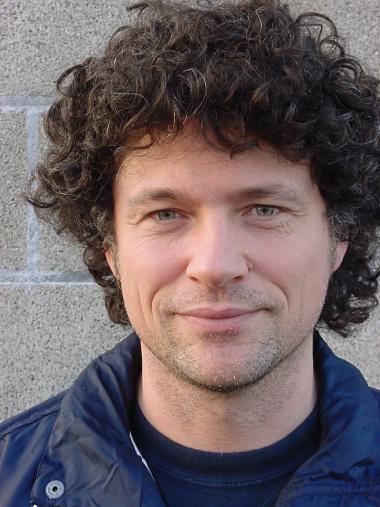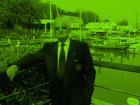
2013-06-18 – In 2014, Molenbeek-Saint-Jean will be ‘Cultural Capital’. This title, along with the accompanying budgetary support from the Wallonia-Brussels Federation and the French Community Commission for the Brussels Region, is used to highlight the cultural vitality of a city or municipality in Walloniaor Brusselsevery two years.
Pierre-André Itin, the coordinator of the Molenbeek programme,has been hard at work since the beginning of 2013. His first goal has been to meet the people of Molenbeek from all areas and walks of life, and he has opted for a mix of events, cultural activities and social activities. He is not yet able to reveal the programme, which will remain work in progress until the autumn. He is an all-rounder. He likes the label: since he was young, he has been a citizen of the world who hates frontiers, a Brusselsperson to the core.In all he does, he takes a broad view. ‘A view from the helicopter,’ as he puts it: 360 degrees.
Man at the interface
His world and his career are unusual, because this jack of all trades lays claim to no specific discipline as his own. At the age of 18, he dreamt of going into the theatre, but after being rejected by Insas (the National Higher Institute for Performance Arts) realised that he was perhaps even fonder of working on the form and presentation aspects of shows and performances than their content. So it was that he joined Club Med, as a G.O. of course, ‘but it’s no holiday. Behind the scenes, you’re in a highly supervised world. I developed an understanding of the consumer public, and of communicating with a team’. He quickly became an activities coordinator.
Four years later, the so-called ‘promo-boys’ or ‘male hostesses’ were launched in Belgium. He found a job in the sector, worked on different events, observed…and became a coordinator. He took on assignments in the public and private events sector, and in the process took part in the launch of the Ligue d’Impro, where he remained for ten years. Alongside this, for the past twenty years he has also coordinated the Caïus prizes for business patronage of the arts, something which has enabled him to bridge the gap between the public and private sectors and initiators of cultural projects. His entire career has thus taken place at the interface between the cultural sector and private, corporate and public events.
Today, he has two completely different areas of responsibility. As a consultant for VisitBrussels, he coordinates the Tram Experience project, which was initiated in connection with ‘Brusselicious 2012, gourmet year’ and has been extended: ‘People are queuing up to have dinner for 75 euros in a tram which travels through the city,’ he exclaims.
Energy catalyst
In parallel, Pierre-André Itin is running Molenbeek 2014, a one-shot event of which full advantage needs to be taken. After Liège in 2010 and La Louvièrein 2012, it was the turn of the Brussels-Capital Region to host the ‘Cultural Capital’. Half a dozen municipalities (some of them grouped together) responded to the call for projects from the Wallonia-Brussels Federation. It was Molenbeek that won the competition in front of the panel of judges, with an application that was put together – before his arrival – by the Subsidised Works Service, the District Contracts, the Arts Centre, the Cultural Service and the Museum.‘We’re not creating some “thing” for the occasion,’ explains Pierre-André Itin. ‘We’re spotlighting what’s already there, the municipality’s assets, openness, diversity and ability to unify. There are 300 clubs and voluntary organisations to meet, so it will be quite a feat to channel and organise all that energy.’
He is proceeding via units, focuses and languages. Partnership agreements are already being formed, and the programme will be unveiled in October. But he is prepared to identify the common theme that will run through the great web he intends to create between people, genders, population groups and age groups: every project must be characterised by its community spirit and its enquiring approach, and must bring together voluntary organisations. His keyword is ‘ “convergence”: between everyone working in their own little worlds; between the goals of Molenbeek 2014 and all these organisations; and between the aldermen.’
Harnessing cultural heritage and cultural dynamism
He defines himself as a free spirit, including politically, so he is conscious of not being tied down. He also believes that limited funding spurs creativity. ‘My philosophy is not protectionism,’ he says, ‘but the money should stay here: I’m not going to go outside Molenbeek in search of big names.’ His approach is thus to improve the visibility of what is already present, and activate as much energy as possible.
He will have one year to put the spotlight on Molenbeek’s cultural heritage and dynamism. He can take advantage of the fact that the Vaartkapoen, a Flemish arts centre, is celebrating its 25th anniversary, but there’s also the 50th anniversary of Moroccan immigration, the 25th anniversary of the Region and a fast-changing Canal zone… One year won’t be enough! The first event is already scheduled for 18 January 2014, and activities will follow one another at a steady pace.
This assignment definitely represents quite a challenge, but Pierre-André Itin is expecting to look back afterwards at a successful year.
Véronique KIRSZBAUM



















